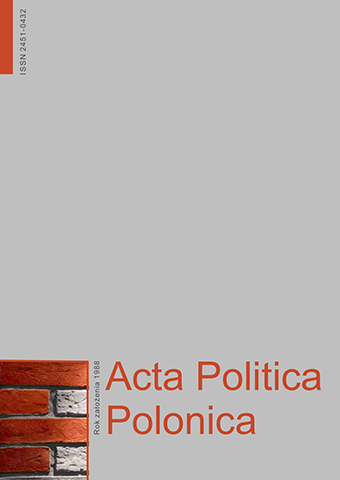
ISSN: 2451-0432
OAI
DOI: 10.18276/ap.2018.44-03




Issue archive /
2/2018 (44)
Cybersecurity as a challenge for modern state and society
| Authors: |
Marek
Górka
Politechnika Koszalińska, Wydział Humanistyczny |
| Keywords: | security policy cyber security cyberspace cyber power cyber conflict |
| Data publikacji całości: | 2018-06-30 |
| Page range: | 11 (29-39) |
Abstract
The Internet makes social and political life more dynamic by increasing the access to information, facilitating political discussion, development of social networking and offering alternative and convenient areas of political involvement. This work focuses on analyzing the political structure of the Internet. An emphasis is put on understanding the theoretical connection between technology and politics. It is also an attempt at answering the question, is World Wide Web the answer to the needs of socio-political potential? How can the Internet have a negative influence on political life? So, in order to understand contemporary events, one needs to understand the specificity of cyberspace, which consists both of continuation and new quality of identity and values for the users.
Download file
Article file
Bibliography
| 1. | Borandi, T. (2009). Introduction to Secure Global Collaboration. Information Security Journal. A Global Perspective, 2 (18), 51–56. DOI: 1080/19393550902791473. |
| 2. | Brantly, A.F. (2014). The Cyber Losers. Democracy and Security, 2 (10), 132–155. DOI: 10.1080/17419166.2014.890520. |
| 3. | Burton, J. (2015). NATO’s Cyber Defence. Strategic Challenges and Institutional Adaptation. Defence Studies, 4 (15), 297–319. DOI: 10.1080/14702436.2015.1108108. |
| 4. | Carr, M. (2016). US Power and the Internet in International Relations. The Irony of the Information Age. New York: Palgrave Macmillan. |
| 5. | Choucri, N., Madnick, S., Ferwerda, J. (2013). Institutions for Cyber Security. International Responses and Global Imperatives. Information Technology for Development, 2 (20), 96–121. DOI: 10.1080/02681102.2013.836699. |
| 6. | Clarke, R.A. (2012). Cyber War. The Next Threat to National Security and What to Do About It. New York: Ecco Press. |
| 7. | The Economist (2010). Cyberwar. The Threat from the Internet. Pobrane z: http://www.economist.com/leaders/2010/07/01/cyberwar (12.08.2016). |
| 8. | Deibert, R.J., Rohozinski, R. (2010). Risking Security. Policies and Paradoxes of Cyberspace Security. International Political Sociology, 1 (4), 15–32. DOI: 10.1111/j.1749-5687.2009.00088.x. |
| 9. | Isenberg, D. (1999). A Cyber Pearl Harbor? More Hype Than Threat. Pobrane z: https://www.joc.com/cyber-pearlharbor-more-hype-threat_19991227.html (12.058.2016). |
| 10. | Jensen, M.J., Danziger, J.N., Venkatesh, A. (2007). Civil Society and Cyber Society. The Role of the Internet in Community Associations and Democratic Politics. The Information Society, 1 (23), 39–50. DOI: 10.1080/01972240601057528. |
| 11. | Junio, T.J. (2013). How Probable is Cyber War? Bringing IR Theory Back In to the Cyber Conflict Debate. Journal of Strategic Studies, 1 (36), 125–133. |
| 12. | Mazanec, B.M., Thayer, B. (2016). Deterring Cyber Warfare. Bolstering Strategic Stability in Cyberspace. New York: Palgrave Macmillan. |
| 13. | Messmer, E. (2012). Stuxnet and Flame share code, development teams. Kaspersky Lab Says Early Version of Stuxnet Has a Flame Module. Network World. Pobrane z: https://www.networkworld.com/article/2189257/security/stuxnet-and-flame-share-code--development-teams.html (12.08.2016). |
| 14. | Cybersecurity Policy (2008). National Security Directives George W. Bush Administration, 54. Pobrane z: https://fas.org/irp/offdocs/nspd/nspd-54.pdf (12.08.2016). |
| 15. | Nye, J.S. (2011). The Future of Power. New York: PublicAffairs. |
| 16. | Oates, B. (2001). Cyber Crime. How Technology Makes it Easy and What to Do About it. Information Systems Management, 3 (18), 92–96. DOI: 10.1201/1078/43196.18.3.20010601/31295.12. |
| 17. | Ormrod, D., Turnbull, B. (2016). The Cyber Conceptual Framework for Developing Military Doctrine. Defence Studies, 3 (16), 270-298. DOI: 10.1080/14702436.2016.1187568. |
| 18. | Peterson, D. (2013). Offensive Cyber Weapons: Construction, Development, and Employment. Journal of Strategic Studies, 1 (36), 120–124. DOI: 10.1080/01402390.2012.742014. |
| 19. | Richards, J. (2016). Cyber-War. The Anatomy of the Global Security Threat. New York: Palgrave Macmillan. Rid, T. (2012). Cyber War Will Not Take Place. Journal of Strategic Studies, 1 (35), 5–32. DOI: 10.1080/01402390.2011.608939. |
| 20. | Rid, T., McBurney, P. (2012). Cyber-Weapons. The RUSI Journal, 1 (157), 6–13. DOI: 10.1080/03071847.2012.664354. |
| 21. | Roberts, L.D., Indermaur, D., Spiranovic, C. (2013). Fear of Cyber-Identity Theft and Related Fraudulent Activity. Psychiatry, Psychology and Law, 3 (20), 315–328. DOI: 10.1080/13218719.2012.672275. |
| 22. | Schroefl, J., Kaufman, S.J. (2014). Hybrid Actors, Tactical Variety. Rethinking Asymmetric and Hybrid War. Studies in Conflict & Terrorism, 10 (37), 862–880. DOI: 10.1080/1057610X.2014.941435. |
| 23. | Simpson, B., Murphy, M. (2014). Cyber-Privacy or Cyber-Surveillance? Legal Responses to Fear in Cyberspace. Information & Communications Technology Law, 3 (23), 189–191. DOI: 10.1080/13600834.2014.978551. |
| 24. | Summers, Ch. (2015). Hacking group Anonymous declares ‘Cyber War’ on Turkey for ‘Supporting ISIS’. Daily Star, 23 grudnia. |
| 25. | Thomas, T. (2014). Creating Cyber Strategists. Escaping the ‘DIME’ Mnemonic. Defence Studies, 4 (14), 370–393. DOI: 10.1080/14702436.2014.952522. |
| 26. | Trim, P., Upton, D. (2016). Cyber Security Culture. Counteracting Cyber Threats through Organizational Learning and Training. London–New York: Routledge. |
| 27. | Vacca, W.A. (2011). Military Culture and Cyber Security. Global Politics and Strategy, 6 (53), 159–176. DOI: 10.1080/00396338.2011.636520. |